
Scuba diving in Tahiti: the best spots of the islands
French Polynesia is a diver's paradise. Mythical locations and islands, such as the famous Rangiroa and Fakarava, delight scuba divers from around the world with their unique beauty. On the drop-offs, in the passes, and in some areas where the coral form garden-like structures, you will encounter some of the world's rarest and most beautiful marine life on Earth.
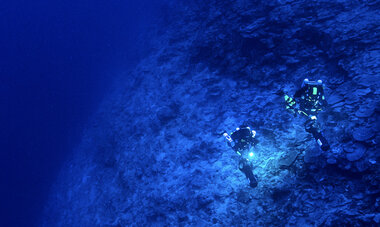
The Everest of Diving
For those unfamiliar with diving, it can be surprising to hear divers talk about their favorite spots and hear two seemingly contradictory terms used together: Polynesia and Everest. But when you think about it, this puzzling association makes perfect sense: French Polynesia is the Mount Everest of diving. Our islands are a dream destination for scuba enthusiasts, even if competition is particularly fierce in the South Pacific.
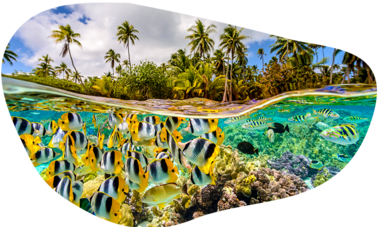
The Coral Magic in The Islands of Tahiti
This gift comes from geology. It all began around 3 million years ago, when ancient islands started to erode and sink while coral grew along their edges. Over the next 2 million years, as sea levels rose, the oldest islands, which were eroded or too low, disappeared. The coral structures formed the circular rings we now know as coral reefs, creating lagoons & reef passes that connect the ocean to the calm inner waters. The lagoons are heavens for life, where coral gardens bloom like underwater forests and marine ecosystems flourish in harmony.
French Polynesia’s Underwater World
Atolls were formed this way. There, dozens of meters below the surface, from the clearest shades of blue to the darkest, an incredibly rich marine life has developed.
French Polynesia is home to 85 atolls, including 76 in the Tuamotu Islands, 2 in the Gambier Islands, one in the Marquesas and Austral Islands, and five in the Society Islands (Tetiaroa north of Tahiti, heart-shaped Tupai north of Bora Bora, Manuae, Motu One, and Maupiha'a west of Maupiti and Bora Bora). Their aquatic life is absolutely exceptional: here, the atolls are sparsely populated, fishing is sustainable, ecosystems are respected, and the marine biodiversity is truly remarkable.
In addition, there are 34 high islands spread across five archipelagos, most of which are surrounded by lagoons protected by reefs that are home to a rich variety of marine flora and fauna.
Therefore, if you only dive once in your life, this is the place to do it!
Pros or beginners: a diving experience for every level
While popular diving islands like Rangiroa and Fakarava attract seasoned divers from around the world, nearly every island offers diving experiences suited to all levels. Diving clubs are spread across the islands and atolls. Your hotel or travel agency will be able to recommend the best dive club for you based on where you are staying.
Now, here's what you really want to know: what are the must-see diving spots in French Polynesia? It all depends on your level.
The best spots have been identified on all the islands, each with their own remarkable characteristics: coral gardens, faults, cavities, shipwrecks, and plane wrecks (such as the Catalina seaplane and the Orohena schooner in the Faa'a lagoon in Tahiti).
Without exception, all the islands offer remarkable dives, with sites for all levels, from first-timers to certified pros. They all have enchanting names, promising a rare moment in harmony with these fragile and preserved ecosystems: Rose Garden, Stingray Corridor, Coral Wall, White Valley, The Aquarium, La Source in Tahiti, Muri Muri in Bora Bora...
The Best Diving Spots on the Islands
The reef passes are best reserved for experienced divers due to the currents. But this is undoubtedly where the most thrilling experiences await. The passes of Tiputa in Rangiroa and Garuae in Fakarava, 1.6 km wide (1 mile), are perfect to drift dive from the outer drop-off of the lagoon (ocean side). Videographers and photographers from around the world come to capture these world-class diving spots, nicknamed the Everest of diving.
In these passes, you will swim through multicolored coral canyons, encountering eagle rays, leopard rays, manta rays, playful dolphins, nonchalant turtles, and fish of all shapes and colors. But you will also encounter the largest predators, including mako sharks (the fastest in the world), parata (white fin), tapete (white tip), raira (gray), arava (lemon), and toretore (tiger shark). The ancient Polynesians considered sharks to be messengers of the god Ta'aroa and totem animals protecting noble families. Sharks have been protected in French Polynesia for over 50 years. Check out our diving packages to book a perfect trip around the islands.
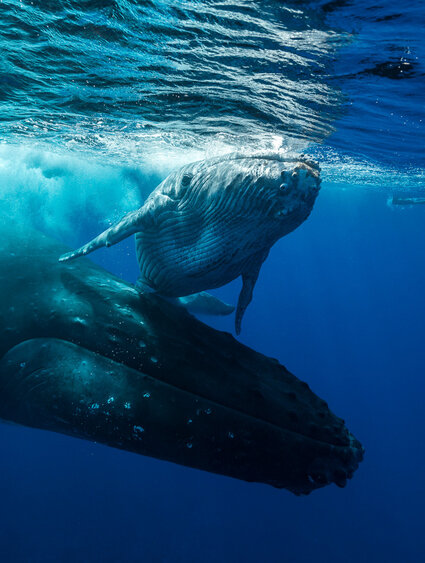
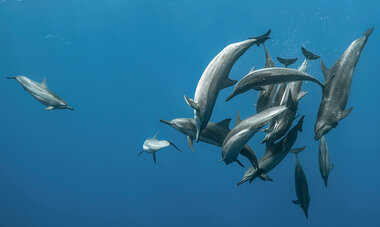
Where to dive in Fakarava?
In this atoll where the painter Matisse discovered the blue that made him famous, two dive sites are particularly popular:
- Garuae (north), the largest pass in French Polynesia (1 mile wide, or 1,600 meters)
- Tumakohua, also known as Tetamanu (south).
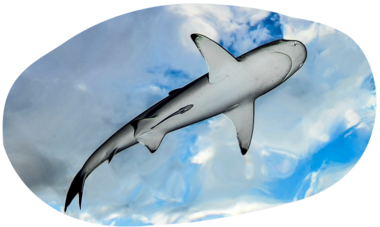
Diving in Rangiroa: Tiputa and Avatoru
The best diving spots of Rangiroa are located in the two passes of Tiputa and Avatoru. These world-renowned spots offer thrilling drift dives through canyons teeming with dolphins, rays, turtles, and sharks. This is the kind of diving people train their whole lives for.
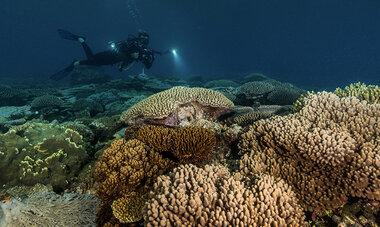
Dive Spots in Bora Bora
In the Teavanui Pass, for a drift dive, or at the Muri Muri site, in a rich coral field, in clear blue waters. Bora Bora is also one of the best places for snorkeling in The Islands of Tahiti.
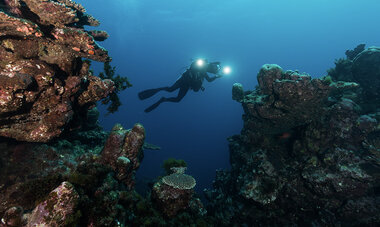
The Coral Wall Diving Spot in Moorea
Without a doubt, the place named Coral Wall is the best of Moorea. This iconic site offers stunning underwater views and is accessible for most divers.
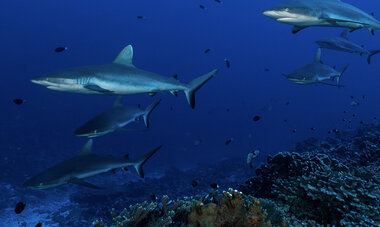
Where to dive in Tikehau?
Along with Rangiroa and Fakarava, Tikehau is another Tuamotu atoll, perfect for diving enthusiasts. There are two main dive sites: the Pearl Farm, a former farm now used as a manta ray nursery, ideal for level 1 divers, and the Shark Hole ("trou aux requins"), for experienced divers (level III).
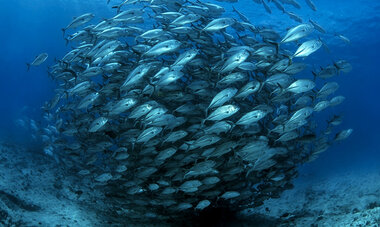
The Best Diving Spot in Raiatea
In the lagoon, at a site known as Les Roses, coral structures are home to countless fish. This is a dive for experienced divers (level II).
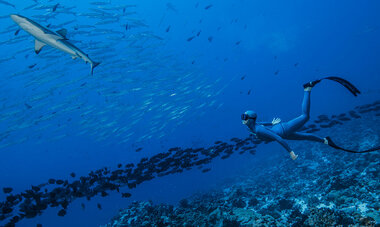
Diving in Huahine: Spots for Beginners
Huahine is a magnificent island of the Society Archipelago. To find a good diving spot, head to Fa'a Miti in the north of the island and the Avapehi Pass, where you can drift without strong currents. These two sites are ideal for beginners.
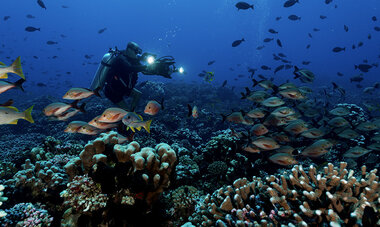
Where to dive in Maupiti?
At the Motu Tuanai in the southeast of the island, where the underwater fauna is very rich, in a translucent turquoise lagoon. There is only one diving center in Maupiti.
Our tips for diving in Tahiti and the other islands
In the Marquesas, there is only one diving center, in Hiva Oa.
Most islands offer discovery dives and Level 1 certification. We’ve shared some of the most beautiful spots, but there are countless hidden gems. Talk with diving instructors and locals to find all the best spots of French Polynesia.
To the frequently asked question: will you see whales during your dives? The answer is not necessarily. Humpback whales mostly visit our waters from July to October. While sightings during dives are rare, you might just get lucky and spot a mother and calf. If you want to see some whales, join a dedicated respectful whale-watching excursion.